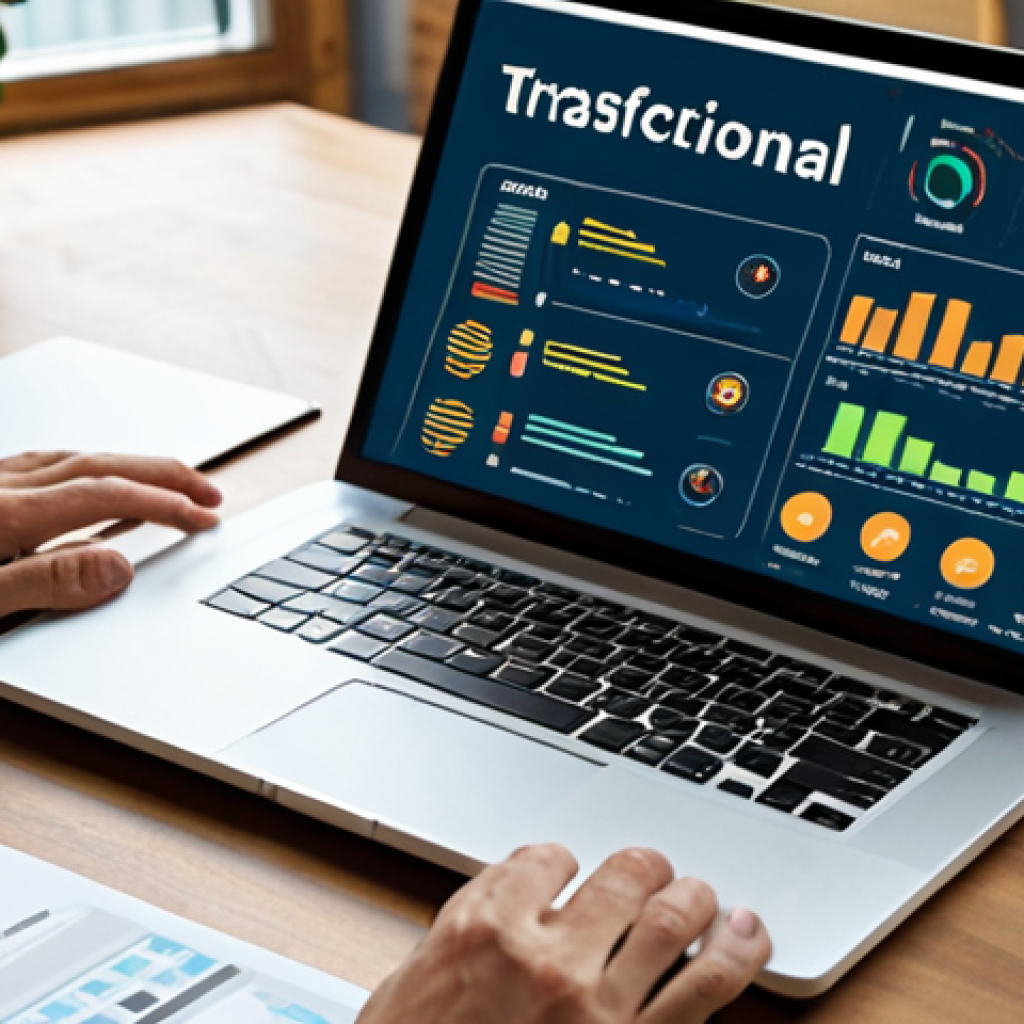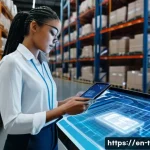You know, navigating the ever-shifting currents of the transportation sector isn’t just about moving goods from A to B anymore. I’ve personally watched seasoned professionals, the ones who truly excel, adapt their decades of experience to embrace everything from predictive analytics to sustainable logistics, almost as if they have a crystal ball.
They’ve lived through countless supply chain disruptions and technological leaps, transforming challenges into opportunities with an almost intuitive grasp of the industry’s pulse.
It’s a fascinating blend of grit, deep-seated knowledge, and an impressive knack for future-proofing their skills in a world leaning heavily into automation and green initiatives.
Wondering how they consistently stay ahead of the curve? Let’s explore this in detail below.
Embracing Digital Transformation and Data Prowess

It feels like only yesterday that supply chain managers relied primarily on intuition and a well-kept Rolodex. But boy, have things changed! The truly exceptional professionals I’ve encountered in transportation aren’t just dabbling in digital tools; they’ve become absolute masters of them, turning data into their most potent weapon.
They understand that predictive analytics isn’t just a buzzword; it’s the crystal ball they never had, enabling them to anticipate everything from fluctuating fuel prices to unexpected port delays with an accuracy that frankly used to be unimaginable.
I recall a time when one particularly astute logistics director, someone I deeply respect, told me how integrating real-time GPS tracking with weather pattern data allowed his team to reroute an entire convoy of perishable goods, saving millions when a sudden blizzard crippled a major highway.
It wasn’t about having the fanciest software; it was about the foresight to combine disparate data points and the leadership to act decisively on those insights.
This proactive approach, fueled by an insatiable hunger for data, is what separates the merely good from the genuinely great in our industry today. They don’t just collect data; they live and breathe it, constantly questioning, analyzing, and refining their models to ensure every decision is backed by solid evidence rather than just a gut feeling.
Navigating the AI and Automation Landscape
The shift towards AI and automation can feel intimidating, even for veterans. I’ve seen firsthand how some initial resistance melted away once they witnessed the sheer efficiency gains.
It’s not about robots replacing people; it’s about intelligent systems empowering people to do more complex, value-added work. Think about automated warehousing systems – the seasoned pros aren’t threatened by them; they’re figuring out how to optimize the human-machine interface, design more efficient workflows around these technologies, and leverage robotic process automation (RPA) to handle the mundane, repetitive tasks that used to eat up valuable time.
One colleague shared how implementing an AI-powered route optimization system, initially met with skepticism by some long-haul drivers, eventually reduced fuel consumption by 15% and cut delivery times significantly, leading to better driver morale because they were spending less time stuck in traffic.
It’s about adapting your mindset from “how do I do this manually?” to “how can technology help me do this smarter and faster?” This requires a willingness to unlearn old habits and a genuine curiosity for new possibilities, a trait I consistently observe in those who truly thrive.
Leveraging Big Data for Strategic Advantage
The sheer volume of data available now from IoT sensors, telematics, and global trade platforms is staggering. For the most successful professionals, this isn’t overwhelming; it’s an opportunity.
They’ve honed their ability to identify key performance indicators (KPIs) that truly matter and to filter out the noise. I remember a conversation with a freight forwarder who was able to pinpoint a recurring bottleneck in a specific international shipping lane simply by analyzing historical customs data and vessel movement patterns over several years.
This wasn’t about a single incident; it was about identifying systemic issues that others missed. By understanding these macro trends, they could negotiate better rates, anticipate capacity shortages, and even advise clients on optimal shipping times.
Their secret? They don’t just look at the numbers; they connect them to the real-world implications, using data visualization tools to tell compelling stories that drive strategic decisions.
It’s a powerful blend of analytical rigor and practical experience, allowing them to see patterns where others only see a chaotic mess of spreadsheets.
Mastering Supply Chain Resilience in Unpredictable Times
The last few years have been a rollercoaster, haven’t they? From global pandemics to geopolitical shifts, supply chains have been tested like never before.
And frankly, the pros who are truly excelling aren’t just reacting to disruptions; they’re building supply chains that are inherently robust, flexible, and capable of weathering any storm.
They’ve learned, often through painful experience, that relying on a single source or a just-in-time model without robust contingency plans is a recipe for disaster.
I vividly recall the chaos of the Suez Canal blockage; while many companies scrambled, the most prepared logistics managers activated pre-planned alternative routes, quickly chartered new vessels, and communicated proactively with their clients.
Their “secret” wasn’t magic, it was meticulous planning and a deep understanding of multi-modal transportation options. They embraced the idea of building in redundancy, diversifying their supplier base across different geographies, and even exploring nearshoring or reshoring critical components, all while keeping a hawk’s eye on lead times and geopolitical stability.
Diversifying and De-risking Global Networks
One of the most profound shifts I’ve observed is the move away from hyper-optimized, lean supply chains towards more resilient, diversified ones. The seasoned experts understand that true cost isn’t just the lowest per-unit price; it’s the total cost of potential disruption.
This often means cultivating relationships with multiple suppliers in different regions, even if the immediate cost is slightly higher. I’ve sat in meetings where veteran procurement specialists argued passionately for a ‘dual-source’ strategy for critical components, explaining how the marginal extra cost was a tiny insurance premium against massive production stoppages.
They’ve moved beyond simple cost arbitrage to a comprehensive risk assessment, considering everything from labor stability to climate change impacts in different sourcing regions.
It’s a strategic chess game, constantly evaluating potential threats and moving pieces to minimize vulnerability across the entire network, ensuring that one hiccup doesn’t bring the whole operation to a grinding halt.
Proactive Crisis Management and Communication
When a crisis hits, clear, calm, and constant communication is absolutely paramount, and this is where true leadership shines. I’ve witnessed supply chain veterans navigate catastrophic events with a quiet confidence that inspires trust.
They don’t wait for problems to escalate; they establish early warning systems, conduct regular scenario planning exercises, and develop communication protocols long before a crisis looms.
During a major port strike, for instance, a logistics manager I know immediately convened daily calls with all affected stakeholders – carriers, clients, and internal teams – providing transparent updates on delays, proposed solutions, and revised timelines.
This wasn’t about sugarcoating the situation; it was about managing expectations, offering realistic alternatives, and maintaining credibility. Their ability to quickly assess the situation, formulate actionable plans, and disseminate information effectively is a critical skill that minimizes panic and keeps the wheels of commerce turning, albeit sometimes on a slightly different path.
Driving Towards Sustainable and Ethical Logistics
The transportation sector, let’s be honest, hasn’t always been at the forefront of environmental responsibility. But that narrative is rapidly changing, and the most visionary professionals are not just adapting; they’re leading the charge towards a greener future.
It’s not just about corporate social responsibility anymore; it’s about economic viability, regulatory compliance, and meeting increasingly stringent consumer and stakeholder demands.
I’ve personally seen companies invest heavily in electric vehicle fleets, optimize routes to reduce emissions, and explore alternative fuels, not because it’s a trend, but because they genuinely believe it’s the right thing to do and ultimately, it makes good business sense.
They understand that a smaller carbon footprint can lead to lower operational costs in the long run, attract top talent who prioritize ethical employers, and open up new market opportunities with environmentally conscious clients.
This isn’t lip service; it’s a fundamental rethinking of how goods move, from the first mile to the last.
Implementing Eco-Friendly Transportation Solutions
From my perspective, the drive towards eco-friendly solutions is multifaceted, going far beyond just replacing diesel trucks with electric ones. It encompasses everything from optimizing freight loads to reduce the number of trips, to leveraging intermodal transportation where rail and sea contribute to lower emissions per ton-mile.
I was particularly impressed by a regional logistics firm that redesigned its entire urban delivery network to incorporate electric cargo bikes for last-mile delivery in congested city centers.
It not only drastically cut emissions but also improved delivery times and reduced operational costs associated with traditional vans. These professionals are constantly evaluating emerging technologies – hydrogen fuel cells, sustainable aviation fuels, even drone deliveries for niche applications – and are willing to pilot projects to test their viability.
They’re asking the tough questions: “Can we source renewable energy for our warehouses?” “Can we implement reverse logistics for packaging reuse?” It’s a holistic approach that seeks to embed sustainability into every facet of their operation.
Navigating Regulatory Changes and Ethical Sourcing
Staying ahead in transportation means grappling with an ever-evolving landscape of environmental regulations and ethical sourcing demands. What was acceptable five years ago might be a major liability today.
I’ve witnessed seasoned pros dedicate significant resources to understanding complex international emissions standards, new waste disposal regulations, and anti-slavery legislation impacting their supply chains.
They’re not just reacting to compliance deadlines; they’re proactively engaging with policymakers, investing in advanced tracking and auditing systems, and collaborating with their suppliers to ensure transparency and accountability throughout the entire value chain.
One logistics specialist told me about the extensive efforts his company undertook to map every supplier in their network, ensuring that no unethical labor practices or environmentally damaging processes were hidden.
This commitment to ethical sourcing isn’t just about avoiding fines; it’s about protecting brand reputation and building consumer trust in a world where transparency is increasingly non-negotiable.
Cultivating Adaptive Leadership and Talent Development
In a sector that’s constantly shifting gears, leadership can’t be static. The most effective transportation leaders I know are not just giving orders; they’re cultivating a culture of continuous learning and adaptability within their teams.
They understand that their most valuable asset is their people, and investing in talent development isn’t just a nice-to-have; it’s an absolute necessity for staying competitive.
I’ve seen firsthand how a leader who encourages experimentation and embraces failure as a learning opportunity can transform a hesitant team into a powerhouse of innovation.
It’s about empowering individuals at every level to think critically, solve problems creatively, and take ownership of their roles, rather than just following a rigid set of instructions.
This nurturing environment fosters resilience and ensures that the entire organization is prepared to pivot quickly when market conditions or technological advancements demand it.
Fostering a Culture of Continuous Learning and Upskilling
The rapid pace of technological change means that skills learned five or ten years ago might already be partially obsolete. The best leaders combat this by instilling a fervent dedication to continuous learning.
They sponsor training programs for everything from advanced data analytics to cybersecurity protocols, understanding that upskilling their workforce is not an expense but a crucial investment.
I worked with a company that implemented a fantastic internal mentorship program, pairing experienced dispatchers with younger professionals eager to learn about new route optimization software.
It wasn’t just about formal courses; it was about creating an environment where knowledge sharing was celebrated, and individuals were actively encouraged to explore new tools and methodologies.
This isn’t just about keeping up; it’s about proactively shaping the future workforce, ensuring that their teams possess the agility and expertise to navigate future challenges, whatever they may be.
Empowering Teams and Decentralizing Decision-Making
Micromanagement is a luxury no modern transportation leader can afford. The complex, fast-moving nature of global logistics demands a decentralized approach to decision-making, where highly skilled teams on the ground can respond swiftly to localized challenges.
I’ve observed leaders who successfully push authority down the chain, empowering their operational managers to make real-time adjustments based on immediate circumstances, rather than waiting for top-down directives.
This fosters a sense of ownership and accountability. For instance, during a sudden surge in demand, a regional distribution center manager, empowered by clear guidelines and trusted by her leadership, quickly adjusted staffing levels and rerouted delivery trucks without needing multiple layers of approval, thus minimizing delays.
This trust and empowerment are cultivated through clear communication of strategic objectives, robust training, and a willingness to support teams even when things don’t go perfectly, knowing that mistakes are often the best teachers.
Leveraging Global Networks and Cross-Cultural Acumen
The globalized nature of transportation means that success isn’t just about moving goods efficiently; it’s about navigating a labyrinth of diverse cultures, regulatory frameworks, and geopolitical nuances.
The standout professionals I admire have an almost intuitive grasp of international trade dynamics, cultivating extensive networks that span continents.
They understand that a strong relationship with a customs broker in Shanghai can be just as crucial as an optimized warehouse in Chicago. This isn’t something you learn from a textbook; it’s built through years of patient, respectful interaction, understanding local customs, and demonstrating genuine empathy.
I’ve seen how a small gesture, like understanding the appropriate business etiquette for a meeting in Japan, can unlock opportunities that technical proficiency alone never could.
It’s about building bridges, not just routes, across borders.
Building Robust International Partnerships
The truly global players in transportation recognize that they can’t do it all alone. They build deep, symbiotic relationships with international partners – freight forwarders, carriers, customs agencies, and even local governments.
These aren’t just transactional agreements; they are strategic alliances built on mutual trust and shared objectives. I recall a difficult negotiation involving a perishable shipment stuck at a port due to unexpected paperwork.
The experienced logistics manager, leveraging a decade-long relationship with a local agent, managed to expedite the process, saving the client from significant losses.
It wasn’t about pulling strings; it was about the established credibility and goodwill that allowed for swift, effective problem-solving. They invest time in understanding their partners’ challenges and help them succeed, knowing that their success is intrinsically linked to their own.
This network of trusted allies becomes an invaluable asset when unexpected challenges arise in distant lands.
Navigating Complex Global Trade Regulations and Tariffs
If there’s one area that can give even the most seasoned transportation professional a headache, it’s the ever-changing landscape of global trade regulations, tariffs, and customs procedures.
But for the experts, this complexity is an area where they add immense value. They meticulously track trade agreements, understand specific country-of-origin rules, and stay abreast of sanctions or import restrictions that could impact their operations.
I’ve witnessed supply chain consultants save clients millions by advising on optimal incoterms or helping them leverage duty drawbacks that they weren’t even aware existed.
Their expertise minimizes legal risks, avoids costly delays, and ensures compliance across diverse jurisdictions. It’s a specialized knowledge base that requires continuous effort to maintain, and it highlights how the most successful individuals transform potential pitfalls into strategic advantages for their businesses.
| Key Success Factor | Traditional Approach | Modern Expert Approach |
|---|---|---|
| Technology Adoption | Skepticism, manual processes | Proactive integration, data-driven decisions |
| Supply Chain Resilience | Just-in-time, single sourcing | Diversified networks, redundancy planning |
| Sustainability | Compliance as burden | Strategic advantage, eco-innovation |
| Leadership Style | Top-down, command & control | Empowering teams, continuous learning culture |
| Global Operations | Transactional, limited scope | Deep partnerships, cross-cultural acumen |
The Art of Continuous Learning and Industry Foresight
The transportation sector is a living, breathing entity, constantly evolving with new technologies, geopolitical shifts, and market demands. The truly exceptional professionals aren’t just reacting to these changes; they’re anticipating them, almost as if they have a sixth sense for what’s coming next.
This isn’t magic; it’s the result of an unwavering commitment to continuous learning and a relentless pursuit of industry foresight. They immerse themselves in industry reports, attend niche conferences, engage with startups at the cutting edge, and actively participate in professional networks.
I’ve observed how these individuals spend countless hours dissecting emerging trends, not just in logistics, but in adjacent fields like advanced manufacturing, e-commerce, and even urban planning, understanding that these external forces will inevitably impact the movement of goods.
Their ability to connect seemingly disparate dots and project future scenarios is a testament to their intellectual curiosity and dedication.
Staying Ahead of Emerging Technologies and Trends
It’s easy to get comfortable with what you know, but in transportation, comfort can quickly lead to obsolescence. The leaders I’ve learned from are constantly scanning the horizon for the next big thing.
Whether it’s the widespread adoption of blockchain for supply chain transparency, the development of autonomous vehicles for long-haul trucking, or the potential of hyperloop technology, they’re not just reading headlines; they’re actively exploring how these innovations could disrupt or enhance their operations.
I remember a senior logistics manager who, years before widespread adoption, was already experimenting with RFID tags for inventory management, envisioning a future where every single package could be tracked with pinpoint accuracy.
This wasn’t about jumping on every fad; it was about discerning which technologies offered genuine strategic advantages and then methodically building the expertise to integrate them.
They understand that early adoption, or at least early preparedness, can confer a significant competitive edge.
Cultivating a Network of Industry Peers and Mentors
No one operates in a vacuum, and the most successful transportation professionals understand the immense value of a robust professional network. They actively seek out and cultivate relationships with peers, mentors, and even competitors, recognizing that collective intelligence often trumps individual brilliance.
I’ve personally benefited from these connections, gaining insights into challenges and solutions from people facing similar struggles in different corners of the industry.
It’s about more than just exchanging business cards at a conference; it’s about genuine engagement, sharing experiences, and learning from diverse perspectives.
Whether through informal coffee chats, formal industry associations, or online forums, these individuals are constantly tapping into a wellspring of knowledge, exchanging best practices, and collaboratively brainstorming solutions to systemic industry challenges.
This collaborative spirit not only enriches their own understanding but also elevates the entire sector, fostering a community of problem-solvers.
Crafting Strategic Partnerships and Collaborative Ecosystems
In today’s complex supply chain landscape, going it alone is no longer a viable strategy for sustained success. The most accomplished transportation leaders aren’t just contracting services; they’re forging deep, strategic partnerships that create truly collaborative ecosystems.
They understand that a strong relationship with a technology provider, a last-mile delivery specialist, or even a competitor in a specific niche, can unlock unprecedented efficiencies and open new markets.
It’s about moving beyond transactional interactions to genuine collaboration where shared goals and mutual benefits drive the relationship. I’ve seen companies completely transform their service offerings by partnering with innovative startups, leveraging their agility and specialized tech to complement the established infrastructure of the larger organization.
This isn’t about simply outsourcing; it’s about extending capabilities and building shared value chains that are more resilient and responsive.
Developing Symbiotic Relationships with Technology Providers
The interface between logistics operations and cutting-edge technology is where a lot of magic happens. The most forward-thinking transportation professionals don’t just buy off-the-shelf software; they engage in deep, symbiotic relationships with their technology providers.
They actively provide feedback, co-develop features, and sometimes even invest in the companies that are building the tools they need. I was part of a project where a freight company worked hand-in-hand with an AI logistics platform developer to create a customized forecasting module that precisely met their unique operational demands.
This wasn’t just client-vendor; it was a partnership where both sides were deeply invested in the outcome. This approach ensures that the technology truly serves their evolving needs, rather than them having to adapt their operations to fit a generic solution.
It’s a testament to their vision that they see technology vendors not just as suppliers, but as critical extensions of their own innovation pipeline.
Building Alliances for End-to-End Supply Chain Optimization
Optimizing a single leg of the journey isn’t enough anymore; success lies in optimizing the entire end-to-end supply chain. This holistic view necessitates strong alliances with every link in the chain, from raw material suppliers to final-mile delivery partners.
The experts understand that bottlenecks anywhere in the system will ultimately impact their performance. They proactively engage with upstream and downstream partners, sharing data, coordinating efforts, and establishing joint performance metrics.
I observed a large retailer significantly reduce its inventory holding costs and improve product availability by fostering incredibly tight collaboration with its manufacturers and third-party logistics (3PL) providers.
They held weekly joint planning sessions, shared demand forecasts in real-time, and even co-invested in shared IT infrastructure. This level of integration, while challenging to achieve, creates a seamless flow of goods and information, eliminating waste and dramatically enhancing overall efficiency and customer satisfaction.
It’s a powerful demonstration of how collaboration can yield results far greater than individual efforts.
Closing Thoughts
As I reflect on the incredible evolution within transportation and logistics, one thing stands out with absolute clarity: the true leaders aren’t merely observers of change; they are its architects.
The professionals I’ve had the privilege to highlight throughout this piece aren’t just moving goods from point A to point B; they’re orchestrating intricate global ballets, fueled by predictive insights, unyielding resilience, and a deep-seated commitment to ethical operations.
It’s a dynamic, often unpredictable field, but the constant cultivation of these core competencies is what truly separates the merely good from the genuinely great.
Keep pushing the boundaries of what’s possible, keep learning, and keep nurturing those vital connections – because in this industry, the journey is just as important as the destination.
Useful Information to Know
1.
For unparalleled networking and continuous education, consider becoming a member of reputable industry associations like the Council of Supply Chain Management Professionals (CSCMP) or APICS (now part of ASCM), which offer certifications and regular events.
2.
Deep dive into specialized logistics and supply chain software. Proficiency in Transportation Management Systems (TMS), Warehouse Management Systems (WMS), and Enterprise Resource Planning (ERP) tools like SAP or Oracle is a game-changer for efficiency.
3.
Stay informed about global economic shifts and geopolitical events. Publications like The Wall Street Journal, Financial Times, and leading industry trade journals often provide critical foresight into market volatility and potential supply chain disruptions.
4.
Embrace online learning platforms for courses in data analytics, AI applications in logistics, or sustainable supply chain practices. Many top universities offer certificate programs that can quickly elevate your expertise in these burgeoning areas.
5.
Actively seek out mentors within the industry. The wisdom and practical advice from seasoned professionals who’ve navigated various economic cycles and technological shifts can be invaluable for your career trajectory and problem-solving skills.
Key Takeaways
Success in modern transportation is defined by a blend of digital mastery, unwavering resilience, and a deep commitment to sustainable practices. Leading professionals cultivate adaptive teams, forge strategic global partnerships, and commit to continuous learning to navigate an ever-evolving landscape.
Frequently Asked Questions (FAQ) 📖
Q: How do these seasoned transportation pros manage to seamlessly weave their decades of hard-earned experience with all this new, sometimes overwhelming, technology like predictive analytics or
A: I? A1: Oh, that’s a fantastic question, and honestly, it’s something I’ve been fascinated by for years. I mean, think about it: these aren’t folks who grew up with an iPhone in their hand.
What I’ve observed, time and time again, is that they approach it not as a replacement for their gut feeling, but as an enhancement. I remember one time, a seasoned logistics manager – let’s call him Frank – was looking at a new route optimization software.
Instead of just blindly trusting the algorithm, he’d overlay its suggestions with his own mental map of traffic patterns he’d seen over 30 years, or those tricky weather fronts that always mess things up in certain valleys.
He’d say, “The computer shows me the optimal path, but my brain tells me where the potholes are.” It’s about leveraging the tech to refine, not rewrite, their intrinsic knowledge.
They’re essentially using their experience to validate and even teach the algorithms, making them truly powerful tools, not just shiny new toys. It’s like they’re saying, “Okay, show me what you’ve got, AI, and I’ll tell you if it actually flies in the real world.”
Q: When disruptions, like a sudden port closure or a fuel price hike, inevitably hit, how do these top-tier professionals genuinely manage to flip those challenges into something positive? It sounds almost too good to be true.
A: Believe me, it can feel that way, especially when you’re in the thick of it and everything’s going sideways. But having watched these masters at work, it’s less about a magic trick and more about an ingrained mindset.
They don’t panic. Their first reaction isn’t despair, it’s a calm, almost surgical assessment of the damage and then, critically, a quick pivot. I’ve personally seen a company, hit hard by an unexpected rail strike, completely overhaul their local distribution network in under a week.
Instead of just waiting for the trains to run again, their operations lead, a woman who’d been through more crises than I’ve had hot dinners, said, “This is our chance to stress-test those last-mile delivery partnerships we’ve been debating.” They identified new, local courier services, accelerated pilot programs, and suddenly, what could have been a catastrophic bottleneck became an unexpected opportunity to optimize their regional delivery strategy, finding efficiencies they hadn’t even imagined before.
It was painful, no doubt, but they saw the forced change as an imperative to innovate. It’s about being proactive and not letting a crisis define you, but rather, using it as a catalyst for evolution.
Q: Beyond just implementing new technology, what exactly is that “intuitive grasp” or “grit” that allows them to future-proof their skills and consistently stay ahead? Is it something you can even learn?
A: Ah, now you’re digging into the secret sauce! “Grit” often gets tossed around, but in this context, it’s less about just sticking with it, and more about a relentless curiosity coupled with a profound respect for the nuances of the industry.
I’ve seen it manifest as an almost obsessive need to understand why things work the way they do, not just that they work. For instance, I know a veteran fleet manager who spends his weekends reading about battery chemistry and next-gen alternative fuels, not because his job demands it right now, but because he sees the writing on the wall for EVs and knows he needs to understand the infrastructure shifts coming down the pike.
He’s not just waiting for the company to send him to a seminar; he’s actively, passionately immersing himself in the future. The “intuitive grasp”? That’s earned.
It’s the synthesis of countless solved problems, failed experiments, and real-time adaptations that build an internal ‘database’ of scenarios. It’s when they can look at a new regulation or an emerging market trend and instantly connect the dots, predicting its ripple effects before anyone else.
And can you learn it? Yes, but it’s not from a textbook. It’s through consistent, engaged experience, asking endless “why” questions, and never, ever settling for “that’s just how we’ve always done it.” It’s a continuous, often messy, journey of self-education and resilience.
📚 References
Wikipedia Encyclopedia
구글 검색 결과
구글 검색 결과
구글 검색 결과
구글 검색 결과
구글 검색 결과






